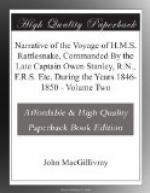“John Macgillivray, Esquire, Naturalist to Her Majesty’s Ship Rattlesnake, lately presented to the British Museum the nest of a South American species of Polistes, which he says is very abundant at St. Salvador, where even in the streets it attaches its nest under the eaves of houses; the species is the Polistes lanio of Fabricius, and in all probability the Vespa canadensis of Linnaeus; a specimen of the species is preserved in the Banksian Cabinet. On examining the nest, I found it consisted as usual of a single comb of cells, having in the centre at the back a short footstalk, by which the nests are attached in their position; the comb contained sixty-five cells, the outer ones being in an unfinished state, whilst twenty-two of the central ones had remains of exuviae in them, and one or two closed cells contained perfect insects ready to emerge; about half a dozen of the wasps had the anterior portion of their bodies buried in the cells, in the manner in which these insects are said to repose. In one cell I observed the head of an insect evidently of a different species, it being black and shining. On extricating it, I discovered it to be a species of Trigonalys; I subsequently carefully expanded the insect, and it proved to be the Trigonalys bipustulatus, described by myself in the Ann. and Mag. of Natural History, volume 7 2nd Series, 1851, from a specimen captured at Para by Mr. Bates, now in the possession of William Wilson Saunders, Esquire. The insect was not enveloped in any pellicle, nor had the cell been closed in any way; the wings were crumpled up at its side, as is usual in Hymenopterous insects which have not expanded them, proving satisfactorily that it had never quitted the cell, and that Trigonalys is the parasite of Polistes.
“This discovery is one of much interest, proving the relationship of the insect to be amongst the pupivora, to which family it had been previously assigned by Mr. Westwood, see Volume 3 Ent. Transactions page 270. The specimen is seven lines in length, entirely black, the head shining, the thorax and abdomen opaque, and having two white maculae touching the apical margin of the basal segment above; the wings are smoky, the antennae broken off. Of one of them I found subsequently seventeen joints—the perfect insect in the possession of Mr. Saunders having twenty joints.”
LEPIDOPTERA.
Drusilla myloecha, Tab. 4 fig. 3, 4.
This fine butterfly* was found flying in considerable plenty in the woods of one of the islands of the Louisiade Archipelago; it forms a very interesting addition to a genus, of which but few species are known, and is allied to the Drusilla catops of Dr. Boisduval, described and figured in the Voyage de l’Astrolabe. The upper sides of the wings of the Drusilla myloecha are of pure white with a silky lustre, the front edge of the fore wings margined with deep brown both above and below; in the male there is a slender white line on the upper side running close to the edge, and extending




